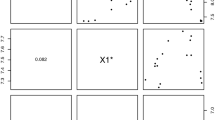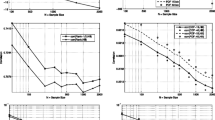Abstract
It is a well-known empirical fact that when informetric processes are observed over an extending period of time, the entire shape of the distribution changes. In particular, it has been shown that concentration aspects change. In this paper the recently introduced co-concentration coefficient (C-CC) is investigated via simple stochastic models of informetric processes to investigate its time-dependence. It is shown that it is important to distinguish between situations where the zero-producers can be counted and those where they cannot. A previously published data set is used to illustrate how the empirical C-CC develops in time and the general features are compared with those derived from the theoretical model.
Similar content being viewed by others
References
Arnold, B. C., Laguna, L. (1977), On generalized Pareto distributions with applications to income data. International Studies in Economics No. 10, Department of Economics, Iowa State University, Ames, Iowa.
Bradford, S. C. (1934), Sources of information on specific subjects. Engineering, 137: 85–86.
Brookes, B. C. (1975), A sampling theorem for finite discrete distributions. Journal of Documentation, 31: 26–35.
Burrell, Q. L. (1980), A simple stochastic model for library Ioans. Journal of Documentation, 36: 115–132.
Burrell, Q. L. (1985), The 80/20 rule: library lore or statistical law? Journal of Documentation, 41: 24–39.
Burrell, Q. L. (1988), Predictive aspects of some bibliometric processes. In: L. Egghe, R. Rosseau (Eds), Informetrics 87/88: Select Proceedings of the First International Conference on Bibliometrics and Theoretical Aspects of Information Retrieval, Amsterdam: Elsevier, pp. 43–63.
Burrell, Q. L. (1990a), Using the gamma-Poisson model to predict library circulations. Journal of the American Society for Information Science, 41: 164–170.
Burrell, Q. L. (1990b), Empirical prediction of library circulations based on negative binomial processes. In: L. Egghe, R. Rousseau (Eds), Informetrics 89/90: Selection of Papers Submitted for the Second International Conference on Bibliometrics, Scientometrics and Informetrics, Amsterdam: Elsevier, pp. 57–64.
Burrell, Q. L. (1991), The Bradford distribution and the Gini index. Scientometrics, 21: 181–194.
Burrell, Q. L. (1992a), The dynamic nature of bibliometric processes: a case study. In: I. K. Ravichandra Rao (Ed.), Informetrics — 91: Selected Papers from the Third International Conference on Informetrics, Bangalore: Ranganathan Endowment, pp. 97–129.
Burrell, Q. L. (1992b), One-step-ahead prediction for a growing database: an empirical Bayes approach. Journal of Scientific and Industrial Research, 51: 756–762.
Burrell, Q. L. (1992c), The Gini index and the Leimkuhler curve for bibliometric processes. Information Processing and Management, 28, 19–33.
Burrell, Q. L. (2001), Stochastic modelling of the first citation distribution. Scientometrics, 52: 3–12.
Burrell, Q. L. (2002a), On the nth citation distribution and obsolescence. Scientometrics, 53: 309–323.
Burrell, Q. L. (2002b), Will this paper ever be cited? Journal of the American Society for Information Science and Technology, 53: 232–235.
Burrell, Q. L. (2003), Predicting future citation behavior. Journal of the American Society for Information Science and Technology, 54: 372–378.
Burrell, Q. L. (2005a), Measuring similarity of concentration between different informetric distributions: Two new approaches. Journal of the American Society for Information Science and Technology, 56: 704–714.
Burrell, Q. L. (2005b), Measuring relative equality of concentration between different income/wealth distributions. International Conference in Memory of Two Social Scientists: C. Gini and M. O. Lorenz. University of Siena, 23–26 May, 2005 http://www.unisi.it/eventi/GiniLorenz05/programme23.htm.
Burrell, Q. L. (2005c), The use of the generalised Waring process in modelling informetric data. Scientometrics, 64: 247–270.
Burrell, Q. L. (2005d), An empirical study of the measurement of similarity of concentration between different informetric distributions. In: P. Ingwersen, B. Larsen (Eds), Proceedings of ISSI 10, Volume 1, Stockholm: Karolinska University Press, pp. 129–139.
Burrell, Q. L. (2005e), Are “Sleeping Beauties” to be expected? Scientometrics, 65: 381–389.
Burrell, Q. L. (2006), Measuring concentration within and co-concentration between informetric distributions: An empirical study. Scientometrics, 68: 441–456.
Burrell, Q. L., Cane, V. R. (1982), The analysis of library data. (With discussion.) Journal of the Royal Statistical Society (Series A), 145: 439–471.
Burrell, Q. L., Fenton, M. R. (1993), Yes, the GIGP really does work — and is workable! Journal of the American Society for Information Science, 44: 61–69.
Dorfman, R. (1979), A formula for the Gini coefficient. Review of Economics and Statics, 61: 146–149.
Egghe, L., Rousseau, R. (1990), Elements of concentration theory. In: L. Egghe, R. Rousseau (Eds), Informetrics 1989/90: Selection of Papers Submitted for the Second International Conference on Bibliometrics, Scientometrics and Informetrics, Amsterdam: Elsevier, pp. 97–137.
Fisher, R. A., Corbet, A. S., Williams, C. B. (1943), The relation between the number of species and the number of individuals in a random sample from an animal population. Journal of Animal Ecology, 12: 42–58.
Glänzel, W., Schoepflin, U. (1994), A stochastic model for the ageing of scientific literature. Scientometrics, 30: 49–64.
Glänzel, W., Schubert, A. (1995), Predictive aspects of a stochastic model for citation processes. Information Processing and Management, 31: 69–80.
Kleiber, C., Kotz, S. (2003), Statistical Size Distributions in Economics and Actuarial Sciences, New Jersey: Wiley.
Lotka, A. J. (1926), The frequency distribution of scientific productivity. Journal of the Washington Academy of Sciences, 16: 317–323.
Mingers, J., Burrell, Q. L. (2006), Modeling citation behaviour in management science journals. Information Processing and Management, 42: 1451–1464.
Parzen, E. (1962), Stochastic Processes, San Francisco: Holden-Day.
Rao, I. K. R. (1988), Probability distributions and inequality measures for analyses of circulation data. In: L. Egghe, R. Rousseau (Eds), Informetrics 87/88: Select Proceedings of the First International Conference on Bibliometrics and Theoretical Aspects of Information Retrieval, Amsterdam: Elsevier, pp. 231–248.
Ross, S. M. (1996), Stochastic Processes, 2nd edition, New York: Wiley.
Schubert, A., Telcs, A. (1989), Estimation of the publication potential in 50 United-States states and in the District-of-Columbia based on the frequency-distribution of scientific productivity. Journal of the American Society for Information Science, 40(4): 291–297.
Sichel, H. S. (1985), A bibliometric distribution which really works. Journal of the American Society for Information Science, 36: 314–321.
Stewart, J. A. (1993), The Poisson-lognormal model for bibliometric/scientometric distributions. Information Processing and Management, 30: 239–251.
Stirzaker, D. (1994), Elementary Probability Theory, Cambridge: Cambridge University Press.
Trueswell, R. W. (1966), Determining the optimal number of volumes for a library’s core collection. Libri, 16: 49–60.
Trueswell, R. W. (1969), Some behavioral patterns of library users: the 80/20 rule. Wilson Library Bulletin, 43: 458–461.
Trueswell, R. W. (1976), Growing libraries: who needs them? In: D. Gore (Ed.), Farewell to Alexandria: Solutions to Space, Growth and Performance Problems of Libraries, Westport, Connecticut: Greenwood Press, pp. 72–104.
Zipf, G. (1949), Human Behaviour and the Principle of Least Effort, New York: Addison-Wesley.
Author information
Authors and Affiliations
Corresponding author
Rights and permissions
About this article
Cite this article
Burrell, Q.L. Time-dependent aspects of co-concentration in informetrics. Scientometrics 73, 161–174 (2007). https://doi.org/10.1007/s11192-007-1688-x
Received:
Published:
Issue Date:
DOI: https://doi.org/10.1007/s11192-007-1688-x




